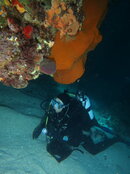Foxfish
Contributor
There has been some recent discussion regarding ocean 'swim throughs' and 'caverns' in some areas. Where I live we have thousands ranging from a few metres to over 20 m.
Assuming:
What are the risks of diving in these "caverns"? What could go wrong?
Avoid debate on this thread the need or otherwise for training to enter these areas. Focus instead on identifying the risks and how you would mitigate the risks. Comments from trained and untrained cave divers are welcome.
Photos don't always tell the whole picture but here are some of the "caverns" we dive that are as described above.





Assuming:
- There is only one clear path and no chance of getting lost;
- The floor is course sand that won't silt even with a group of divers swimming through the cavern;
- It is so spacious that many divers can pass through at the same time;
- The cavern has multiple large entries and exits; and
- It is well illuminated.
What are the risks of diving in these "caverns"? What could go wrong?
Avoid debate on this thread the need or otherwise for training to enter these areas. Focus instead on identifying the risks and how you would mitigate the risks. Comments from trained and untrained cave divers are welcome.
Photos don't always tell the whole picture but here are some of the "caverns" we dive that are as described above.









